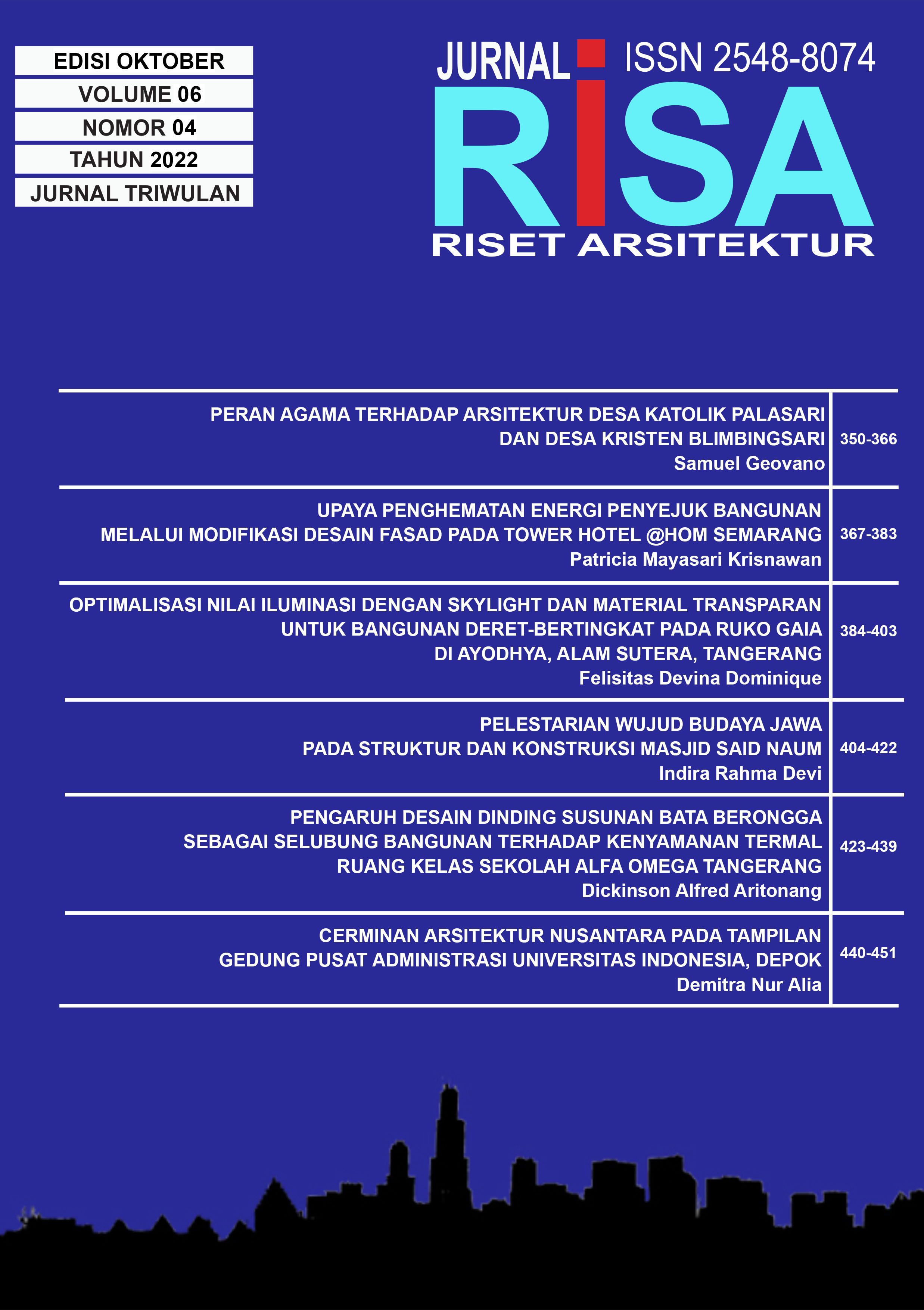CERMINAN ARSITEKTUR NUSANTARA PADA TAMPILAN GEDUNG PUSAT ADMINISTRASI UNIVERSITAS INDONESIA, DEPOK
DOI:
https://doi.org/10.26593/risa.v6i04.6152.440-451Abstrak
Abstrak - Arsitektur Nusantara merupakan pengetahuan turun temurun dalam perihal merancang ruang, yang sesuai dengan kondisi geoklimatik, yang mewujudkan kebhinekaan dari Sabang sampai Merauke. Arsitektur Nusantara dapat digolongkan sebagai suatu unsur kebudayaan, dalam ranah pengetahuan arsitektur. Tanpa disadari, pokok dari ilmu arsitektur Nusantara akan selalu tertanam pada masyarakat Nusantara, seperti sebuah identitas. Rekam jejak Arsitektur Nusantara tercatat di dalam masyarakat lisan, dimana ucapan dan benda menjadi medium mencatat dan merekam pengetahuan terhadap Arsitektur Nusantara. Ketiadaan rekam jejak tertulis memberi kesan bahwa pengetahuan Arsitektur Nusantara seakan sudah tenggelam.
Salah satu rekam jejak arsitektur Nusantara yang dapat ditemukan hingga hari ini adalah bangunan Candi Nusantara, yang bersifat ikonik dan monumental. Bangunan Candi memegang kepentingan dan keutamaan yang melebihi bangunan lain. Kekayaan arsitektur candi Nusantara dapat menggambarkan betapa tingginya budaya, peradaban, dan arsitektur di Nusantara. Selain mewadahi fungsi dan kegiatan tertentu, Candi juga dapat dijadikan alat dalam mengungkapkan budaya Nusantara.
Arsitektur Nusantara seringkali dianggap sebagai hal yang kuno dan ketinggalan zaman. Pengaruh arsitektur Barat lebih mudah diterima masyarakat Nusantara, sehingga mendorong terjadinya peleburan budaya yang memudarkan ke-Nusantara-an dalam arsitektur di Indonesia, mengakibatkan adanya pergeseran di dalam tatanan ruang, tampilan bentuk dan tampang, hingga skala dan proporsi. Arsitektur Nusantara yang mengkini akan bertumbuh, bertransformasi, mengglobal, namun tetap memiliki kekuatan yang bersumber pada konteks lokal.
Penelitian ini bertujuan untuk mengkaji ke-Nusantara-an pada arsitektur objek studi yang berupa bangunan pendidikan yang dibangun pada era modern. Metode Penelitian yang dilakukan adalah kualitatif-deskriptif, melalui pengumpulan data, yang berjalan bersamaan dengan studi pustaka dan literatur yang mendukung. Pada penelitian ini, Teori utama yang digunakan adalah Teori Arsitektur Nusantara oleh Prof. Josef Prijotomo, yang kemudian dibantu dengan metode Unsur-unsur Kuat pada Candi. Persandingan terhadap candi akan digunakan sebagai alat untuk menganalisis objek studi Gedung Pusat Administrasi Universitas Indonesia.
Berdasarkan penelitian ini dapat disimpulkan bahwa Gedung Pusat Administrasi Universitas Indonesia memiliki unsur-unsur kuat candi pada arsitekturnya, dengan mencakup duabelas unsur yaitu hierarki perletakan, axis/sumbu, pembagian tiga, komposisi geometrik, irama dan pengulangan, efek perspektifis, simetri, mimesis, komposisi solid-void, tekstur – elemen garis – efek gelap terang, ragam hias biomimesis, dan material. Dengan memenuhi unsur-unsur candi, dapat diketahui bahwa Gedung Pusat Administrasi Universitas Indonesia mencerminkan Arsitektur Nusantara, melalui proses transformasi dengan percampuran arsitektur modern.
Kata-kata kunci: Arsitektur Nusantara, Candi, Tampang, Gedung Pusat Administrasi Universitas Indonesia
File Tambahan
Diterbitkan
Terbitan
Bagian
Lisensi
Hak Cipta (c) 2022 Demitra Nur Alia

Artikel ini berlisensiCreative Commons Attribution-NonCommercial-ShareAlike 4.0 International License.












